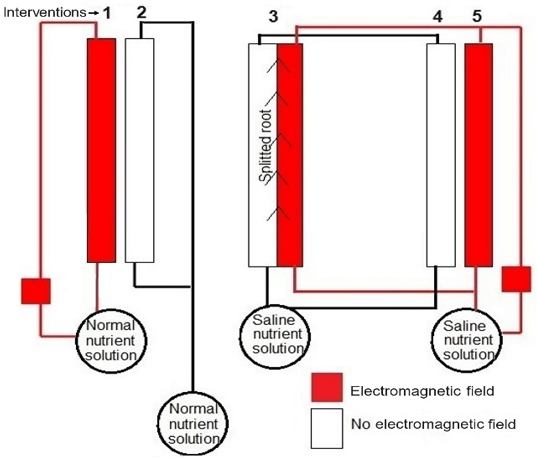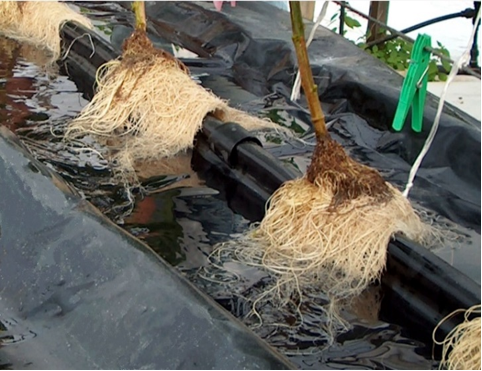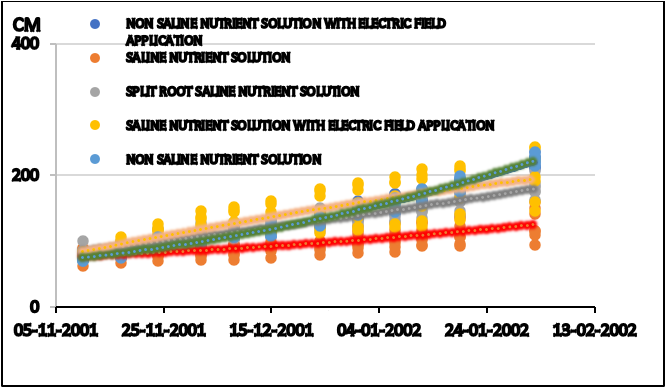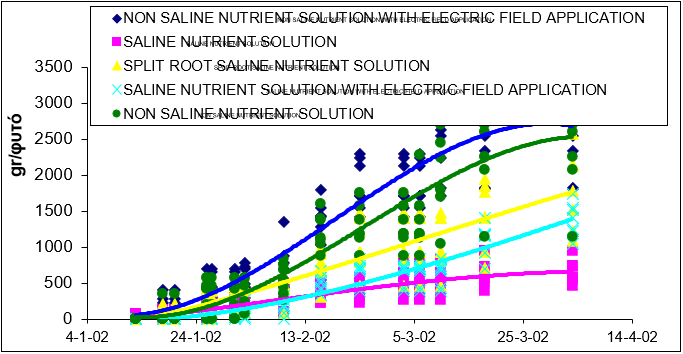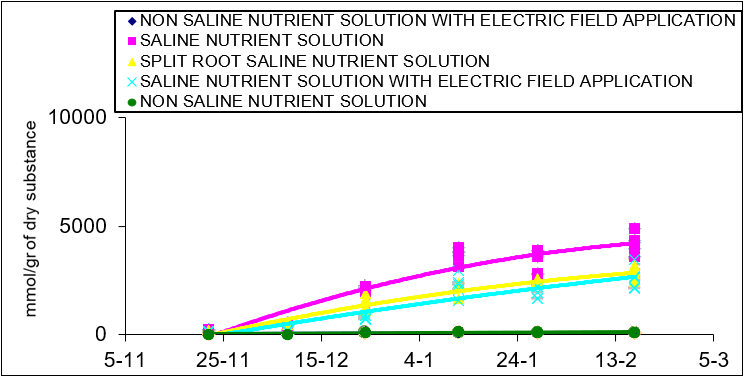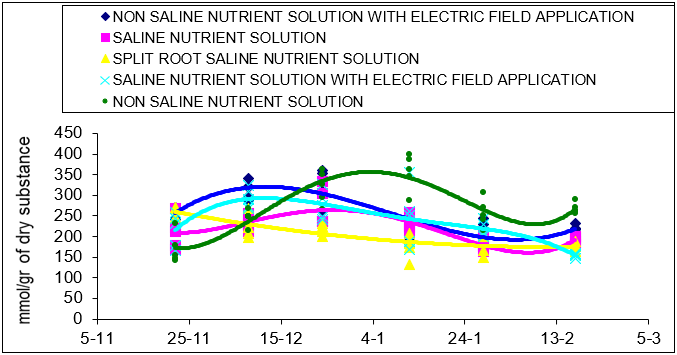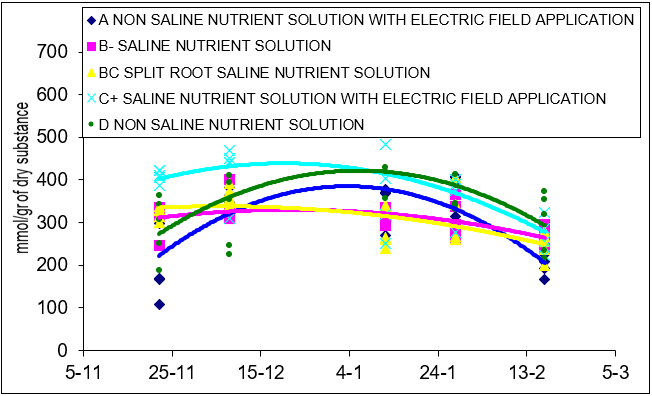Research Article
Volume 5 Issue 3 - 2023
Application of a High-Frequency Electromagnetic Field to Improve the Negative Effect of Saline Water for Irrigation.
*Corresponding Author: G. N. Mavrogianopoulos, Agricultural University of Athens, Greece.
Received: November 16, 2023; Published: November 23, 2023
Abstract
Water is essential to all forms of life, including plants. It plays a crucial role in biological systems. In regions where water is scarce, farmers often have to use saline water in agriculture, due to a lack of good-quality water. Electromagnetic water treatment has been a controversial process for many years. However, in recent years, there has been an increase in commercial electromagnetic water treatment devices that many farmers trust in the agricultural sector. In a plastic greenhouse a few years ago, we used a low-cost device called “AQUASOFT” to create a high-frequency electromagnetic field for the nutrient solution of tomato plants growing in a closed hydroponic system. We found that exposing the nutrient solution, which contained a high amount of NaCl (total conductivity 13 dS m-1), to a high-frequency electromagnetic field just before it reached the plant roots, alleviated salinity stress. When we compared the application of the high-frequency electromagnetic field to the saline nutrient solution, we found that it greatly reduced the concentration of Na+ in the plant leaves, compared to the saline nutrient solution without the effect of the high-frequency electromagnetic field. The height of the plants was the same as those grown in a non-saline nutrient solution. Furthermore, their production was superior to that of the plants growing in a saline nutrient solution without the application of a high-frequency electromagnetic field. The effect of a high-frequency electromagnetic field on the saline nutrient solution was interpreted based on the increase of free water molecules coming from the surface of the hydrated ions and the contribution of the temporary neutralization of several ions due to collisions, originating from the high-frequency electromagnetic field.
Keywords: Irrigation; Saline; Salinity; Electromagnetic field; water treatment; Nutrition
Introduction
In many parts of the world where water is scarce, saline water use is necessary for agriculture. However, prolonged use of such water can adversely affect plant growth and production. Studies conducted by Maas and Hoffman (1977), Sonneveld and Welles (1988), Sonneveld and Voogt (2000), Okon (2019), and others have highlighted these negative effects.
There are several ways to improve the quality of saline water, such as reverse osmosis, ion absorption materials, and the addition of chemicals. However, these methods require a large amount of very poor-quality water to be disposed of, which can be problematic. Additionally, the initial investment and the operating costs for these methods are relatively high. Therefore, low-cost alternatives for improving the efficiency of brackish water in agriculture are useful, particularly given the progress of desertification.
One such alternative is the use of electromagnetic treatment of saline water. The practical application of magnetic fields in agriculture could have both positive and negative effects (Teixeira da Silva and Dobránszki, 2014, Zaidi et al., 2014). However, many farmers in the agricultural sector trust commercial electromagnetic water treatment devices, which have shown promising results in several published papers. For instance, the use of electromagnetic fields in irrigation has yielded positive results in studies by Moon and HS Chung (2000), Hassan et al. (2015), Surendran et al. (2016), Hachicha et al. (2018), Irhayyim et al. (2020), Hamza et al. (2021), and Khaskhoussy et al. (2023). Moreover, in aquaculture research, the use of an electromagnetic field in the solution has been found to improve the solubility of salts and, in general, production (Hassan 2015).
Although electromagnetic water treatment has been successfully investigated in different fields, limited research has been conducted in hydroponic systems. In this regard, we present an unpublished effort made in 2001 at the Agricultural Construction Laboratory of the Agricultural University of Athens to evaluate a low-cost device called "AQUASOFT" for creating a high-frequency electromagnetic field (HFEF) for hydroponic tomato cultivation.
Materials and Methods
The arrangement of the experiment
The experiment was conducted at Athens Agricultural University between October 2001 and March 2002 in a heated plastic greenhouse. Tomato plants were grown in NFT channels. Five different interventions were applied, as shown in Figure 1. The first channel (intervention 1) received a normal nutrient solution, having an Electric conductivity (EC) of 2.5 dS m-1, with the application of a high-frequency electromagnetic field (HFEF). The second channel served as the control group, receiving a normal nutrient solution (EC= 2.5 dS m-1) without any Electromagnetic field application (intervention 2). In the third channel (intervention 3), one-half of the plant roots were irrigated with a saline nutrient solution (EC = 13 dS m-1) without applying any Electromagnetic field, while the other half received the same saline nutrient solution (EC = 13 dS m-1) but with the application of an HFEF (as shown in Figure 1, Image 1). In the fourth channel (intervention 4), the entire root system of the plants was irrigated with saline nutrient solution (EC = 13 dS m-1), without the application of any Electromagnetic field. In the fifth channel (intervention 5), the plants received irrigation with a saline nutrient solution (EC = 13 dS m-1) to which an HFEF was applied.
The experiment was conducted at Athens Agricultural University between October 2001 and March 2002 in a heated plastic greenhouse. Tomato plants were grown in NFT channels. Five different interventions were applied, as shown in Figure 1. The first channel (intervention 1) received a normal nutrient solution, having an Electric conductivity (EC) of 2.5 dS m-1, with the application of a high-frequency electromagnetic field (HFEF). The second channel served as the control group, receiving a normal nutrient solution (EC= 2.5 dS m-1) without any Electromagnetic field application (intervention 2). In the third channel (intervention 3), one-half of the plant roots were irrigated with a saline nutrient solution (EC = 13 dS m-1) without applying any Electromagnetic field, while the other half received the same saline nutrient solution (EC = 13 dS m-1) but with the application of an HFEF (as shown in Figure 1, Image 1). In the fourth channel (intervention 4), the entire root system of the plants was irrigated with saline nutrient solution (EC = 13 dS m-1), without the application of any Electromagnetic field. In the fifth channel (intervention 5), the plants received irrigation with a saline nutrient solution (EC = 13 dS m-1) to which an HFEF was applied.
The experiment involved four tanks filled with nutrient solutions. The first tank contained the normal nutrient solution (EC= 2.5 dS m-1) that was passing through the first channel after applying an HFEF. The second tank contained the same normal nutrient solution (of 2.5 dS m-1), but it went through the second channel without the application of any Electromagnetic field. The third tank contained a saline nutrient solution (EC = 13 dS m-1) that irrigated half of the third channel and the plants in the fourth channel without any Electromagnetic field applied. Finally, the fourth tank contained the saline nutrient solution (EC = 13 dS m-1) for irrigating the other half of the root of the plants in the third channel and the plants in the fifth channel, with HFEF implementation (as shown in Figure 1).
All tanks had the same inorganic nutrient composition, but NaCl was added to the saline solution tanks. The Electrical conductivity of the nutrient solutions was corrected daily with nutrients, along with the pH in all the tanks. The nutrient solutions in all tanks were renewed at regular intervals (7-10 days). That is, the tanks were emptied and new nutrient solutions were filled.
In all tanks, the following concentration of inorganic nutrients was used in the basic nutrient solution: NO3- = 10.5 mmol/l, H2PO4- = 1.5 mmol/l, SO42- = 2.5 mmol/l, NH4+ = 0, 5 mmol/l, K+ = 7.0 mmol/l, Ca2+ = 3.75 mmol/l, Mg2+ = 1.0 mmol/l, Fe = 2.0 mg/l, Mn = 1.0 mg/l, Zn = 0.25 mg/l, B = 0.2 mg/l, Cu = 0.03 mg/l, Mo = 0.05 mg/l.
The saline nutrient solutions in tanks 3 and 4 contain added NaCl during solution renewal. The electrical conductivity of saline solutions averages 13 dSm-1, whereas non-saline solutions have an average EC = 2.5 dS/m-1. The nutrient solutions flow continuously through the channels.
Measurements
As part of the operation, a total of 7 plants were selected at random and their height and production were measured every 15 days. Additionally, 5 leaf samples were taken from the average height of the plants at regular 15-day intervals. These samples were then analyzed for their content of Na+, K+, Ca+2, Mg+2, and P by measuring from their dry matter.
As part of the operation, a total of 7 plants were selected at random and their height and production were measured every 15 days. Additionally, 5 leaf samples were taken from the average height of the plants at regular 15-day intervals. These samples were then analyzed for their content of Na+, K+, Ca+2, Mg+2, and P by measuring from their dry matter.
Results
Root growth
In intervention 3 (split-root), illustrated in Image 2, the root growth was less than 30% on the side where the saline nutrient solution was circulated without the application of a high-frequency electromagnetic field (HFEF). In comparison, the root growth was significantly higher on the side where saline nutrient solution affected by an HFEF was circulated.
In intervention 3 (split-root), illustrated in Image 2, the root growth was less than 30% on the side where the saline nutrient solution was circulated without the application of a high-frequency electromagnetic field (HFEF). In comparison, the root growth was significantly higher on the side where saline nutrient solution affected by an HFEF was circulated.
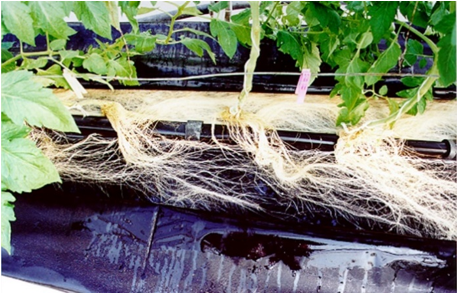
Image 2: Split roots from tomato plants. The upper part of the root was irrigated with a saline nutrient solution that was exposed to a High-Frequency Electromagnetic Field (HFEF), while the lower part of the root was irrigated with a saline nutrient solution that was not exposed to an HFEF.
Plant Height
Based on Table 1 and Diagram 1, it can be concluded that there is no significant statistical difference in the height of plants grown using saline or non-nutrient solution when an HFEF was applied (interventions 1 and 5), and those using the normal nutrient solution (Intervention 2). The plants grown in a saline nutrient solution without the application of an HFEF (Intervention 4). Had the shortest height (Image 3). Moreover, the average height of plants in saline treatment with split root (Intervention 3) showed an intermediate value. Yusuf et al. (2015) reported similar results for tomatoes in the soil.
Based on Table 1 and Diagram 1, it can be concluded that there is no significant statistical difference in the height of plants grown using saline or non-nutrient solution when an HFEF was applied (interventions 1 and 5), and those using the normal nutrient solution (Intervention 2). The plants grown in a saline nutrient solution without the application of an HFEF (Intervention 4). Had the shortest height (Image 3). Moreover, the average height of plants in saline treatment with split root (Intervention 3) showed an intermediate value. Yusuf et al. (2015) reported similar results for tomatoes in the soil.
| Intervention | Average plant height cm (12-2-2002) |
| NON-SALINE NUTRIENT SOLUTION (1) | 224.43a |
| NON-SALINE NUTRIENT SOLUTION WITH ELECTROMAGNETIC FIELD APPLICATION (2) | 221.00a |
| SPLITED ROOT WITH SALINE NUTRIENT SOLUTION (3) | 182.14b |
| SALINE NUTRIENT SOLUTION (4) | 126.50c |
| SALINE NUTRIENT SOLUTION WITH ELECTROMAGNETIC FIELD APPLICATION (5) | 200.14ab |
*(Statistical analysis - Duncan test)
Table 1: Average plant height.
Table 1: Average plant height.
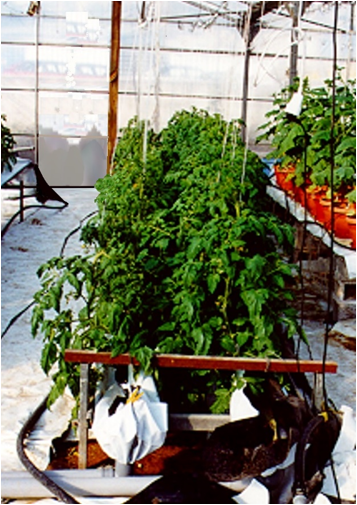
Image 3: Tomato plants are grown in two channels. On the right channel, the plants use the saline nutrient solution affected by CHEFs. On the left channel, the plants use the saline nutrient solution unaffected by CHEFs.
Plant production
Table 2 and Diagram 2 show that the total plant production from non-saline nutrient solutions (interventions 1 and 2) was significantly higher than all other interventions. Among the saline interventions, the ones with HFEF application had a significantly higher average production (intervention “3” and “5”), compared to the saline intervention without the HFEF application (Intervention 4). However, the production of the saline interventions with HFEF application was certainly lower than that of interventions 1 and 2.
Table 2 and Diagram 2 show that the total plant production from non-saline nutrient solutions (interventions 1 and 2) was significantly higher than all other interventions. Among the saline interventions, the ones with HFEF application had a significantly higher average production (intervention “3” and “5”), compared to the saline intervention without the HFEF application (Intervention 4). However, the production of the saline interventions with HFEF application was certainly lower than that of interventions 1 and 2.
| Intervention | g/Φυτo |
| NON-SALINE NUTRIENT SOLUTION WITH ELECTROMAGNETIC FIELD APPLICATION (1) | 2655.4a |
| NON-SALINE NUTRIENT SOLUTION WITNESS (2) | 2461.6a |
| SPLITED ROOT WITH SALΙΝΕ NUTRIENT SOLUTION (3) | 1778.0b |
| SALINE NUTRIENT SOLUTION (4) | 654.5c |
| SALINE NUTRIENT SOLUTION WITH ELECTROMAGNETIC FIELD APPLICATION (5) | 1391.3b |
*(Statistical analysis - Duncan test)
Table 2: Average fruit weight.
Table 2: Average fruit weight.
Mineral elements of the leaves
| ppm→ Intervention | Na+ | K+ | Ca+2 | Mg+2 | P |
| NON-SALINE NUTRIENT SOLUTION WITH HIGH-FREQUENCY ELECTROMAGNETIC FIELD APPLICATION (1) | 62,7a | 1241,6b | 918,8bc | 256,5ab | 292,2c |
| NON-SALINE NUTRIENT SOLUTION (2) | 67,4a | 1497,6a | 1306,1a | 269,7a | 346,9b |
| SPLITED ROOT WITH SALINE NUTRIENT SOLUTION (3) | 1555,1b | 875,0c | 830,6bc | 202,1c | 305,9c |
| SALINE NUTRIENT SOLUTION (4) | 2350,4c | 822,1c | 801,9c | 219,3bc | 305,3c |
| SALINE NUTRIENT SOLUTION WITH HIGH-FREQUENCY ELECTROMAGNETIC FIELD APPLICATION (5) | 1321,5b | 1332,7ab | 1014,9b | 233,8b | 379,4a |
*(Statistical analysis - Duncan test)
Table 3: Average values of concentration of some inorganic elements in the leaves.
Table 3: Average values of concentration of some inorganic elements in the leaves.
Based on the results presented in Table 3 and Diagram 3, it can be concluded that when plants were grown in a saline nutrient solution and subjected to the effect of HFEF (intervention “5”), the average concentration of Na+ in the leaves was significantly lower, throughout the observation period, than the concentration observed in plants grown in saline solution without the effect of any Electromagnetic field (intervention “4”). However, the concentration was much higher than that observed in plants grown in a non-saline environment (interventions “1” and “2”). Moreover, for plants whose root system was separated (intervention "3"), the concentration of Na+ in the leaves was also lower than that observed in plants grown in saline solution without the effect of any Electromagnetic field.
Based on Table 3 and Diagram 4, the average concentration of K+ in the leaves of plants grown in a saline nutrient solution subjected to the effect of HFEF (intervention "5") was statistically similar to the concentration in the leaves of plants grown in a normal nutrient solution (intervention "2" and "1"). However, in the last measurement, a relative decrease was observed, likely due to the rapid growth of fruits. In contrast, the concentration of K+ in the leaves of plants grown in a saline nutrient solution of intervention "4" or intervention "3" was significantly lower.
Based on the data presented in Table 3 and Diagram 5, the average concentration of Ca+2 in the leaves was found to be highest in plants that were grown in a normal nutrient solution without the application of HFEF (intervention "2"), Followed the interventions "5" and "1" with an application of HFEF. On the other hand, the lowest concentration was observed in the saline nutrient solution where HFEF was not applied (intervention "4").
Based on the data presented in Table 3 and Diagram 6, it can be inferred that the average concentration of Mg+2 in plant leaves is the highest in those that were grown in a normal nutrient solution (interventions "2"). The second-highest concentration was found in plants grown in a nutrient solution with the application of an HFEF (intervention "5"). The concentration was comparatively lower in plants with split roots (intervention "3") and in plants grown in a saline nutrient solution without the application of an HFEF (intervention "4").
The highest average concentration of P in the leaves, according to Table 3 and Diagram 7 is observed in the plants grown in the saline nutrient solution with the application of an HFEF (intervention “5”). Followed by the intervention "2". The lowest was that of the plants (interventions "3", "4” and “1”).
Discussion
Based on the results, it is interesting to note that in intervention "3" where the root system was split in a saline nutrient solution, most of the roots grew in the area affected by the High-Frequency Electromagnetic Field (HFEF). This finding is in line with the preference of the root to grow in areas with more free water molecules. Malamy (2005) used mannitol to simulate water stress and found that severe water stress reduced lateral root initiation. Hence, it is not unreasonable to consider that the area under the influence of the HFEF had more free water molecules than the area where the saline nutrient solution was unaffected by the HFEF. In a field experiment, Surendran et al. (2016) also reported that irrigating soil with magnetized water led to higher moisture levels.
It is not entirely clear how this could be achieved, but based on physics, we suggest that it could happen due to the increase in free water molecules that come from the surface of different particles and hydrated ions, which happens through the HFEF. Moreover, collisions that occur during the HFEF process may lead to the temporary neutralization of various ions, while also freeing up water molecules.
The properties of an aqueous solution are heavily influenced by the structure of water molecules and the dissolved elements. Water is a polar molecule, with a positive Electric charge in place of hydrogen, and a negative Electric charge in place of oxygen. When one molecule of salt drops in water, it dissolves in ions, one that carries a positive and another negative electric charge. These ions attract water molecules, which are retained on their surface and form the hydrated ion (Figure 2).
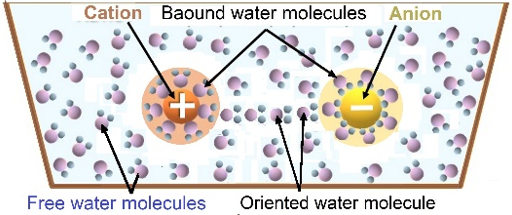
Figure 2: Binding of water molecules by the attraction of electromagnetically charged ions (they create a lower water potential).
In the natural state, dipole water molecules and hydrated ions are arranged and move randomly in a solution. When an HFEF is applied, the dipoles and hydrated ions are rearranged by abrupt rotating and moving. The motion of ions under HFEF cannot perfectly follow the frequency of the oscillation of the Electromagnetic field, so there will be a jerky motion of ions and random collisions between ions. A result of these changes we consider to be the release of several ions-bonded water molecules. These movements last as long as the HFEF is active and for some time afterward.
When salts or other compounds are dissolved in water, it reduces the number of free water molecules and lowers the water potential. This makes it difficult for plants to absorb water. However, when ions get the energy to move in a way that favors conflict, they release water molecules which raises the water potential. This allows more water to pass through to the roots that have lower water potential.
Several studies have demonstrated that magnetic fields can alter the physicochemical properties of water, affecting its hydrogen polarity, bonding, surface tension, pH, conductivity, salt solubility, and refractive index (Amiri et al., 2006; Chang et al., 2008; Cai et al., 2009). However, the efficiency of water treatment with HFEF depends on various factors, including the device used (frequencies and intensity employed), as well as any materials that may obstruct the transmission of electromagnetic waves through the solution.
Regarding the concentration of ions in the leaves of the plants, we observe that, in the non-saline nutrient solution, the high-frequency electromagnetic field (intervention "1") reduced the average concentration of the elements K+, Ca+2, and P in the leaves, compared to the control (intervention "2"). Nevertheless, there was no significant difference neither in the height of the plants nor in the weight of the fruits. Marschner (1995) states that the absorption and distribution of nutrients within plant tissues are complex processes, even in the absence of salinity.
The application of a high-frequency electromagnetic field (intervention “3” and “5”) greatly reduced the average concentration of Na+ in plant leaves, compared to the saline nutrient solution without the effect of the HFEF (intervention “4”). However, the average concentration of K+ remained at the control level, while the concentration of the divalent ions Ca+2 and Mg+2 in the leaves was at the level of intervention "1". The reason for the significant reduction of Na+ in plant leaves, compared to other ions, could be attributed to the much higher concentration of small-diameter Na+ ions in the nutrient solution. This was much higher than all other ions, making the effects of the high-frequency electromagnetic field more significant in the case of Na+. Researchers Hachicha et al (1918) have also presented related results, for potato cultivation. Who reports that using electromagnetic treatment of saline water significantly decreased the adverse effects of saline water and increased significantly K+, N, and P adsorption in all tissues of potato, compared to the saline nutrient solution without the action of an electromagnetic field.
Divalent ions have a greater charge and would be expected to be affected more by the applied HFEF. However, the concentration of these ions in the saline solution used was extremely low compared to the Na+, and hence the effects of the HFEF on them are expected to be relatively very small. In intervention "5", the concentration of P in the leaves was significantly higher than that of the control (intervention 2). On the other hand, the concentration of P in the leaves of plants in intervention “4” (saline nutrient solution without the application of the HFEF), was significantly lower than all the others. These findings are consistent with other studies. Sharpley et al. (1992) reported that salinity reduces the concentration of P in plant tissue. However, some studies conducted in sand or hydroponic cultures, even without applying an electromagnetic field, showed that salinity increased tissue P concentration (Grattan and Grieve, 1994).
In intervention 3, where the root system was separated, the Na+ concentration in the leaves was significantly lower compared to intervention 4. However, the concentration of K+, Ca+2, Mg+2, and P in intervention 3 was at the same level as in intervention 4. This suggests that in intervention 3, an important factor was the movement of high-concentration and small-diameter Na+ ions from one side of the root to the other.
It is important to note that in intervention '5' (HFEF) plant reached a height of the same level as in intervention '2' (control). However, in terms of production, although there was an increase compared to the saline nutrient solution of intervention "4", it did not reach the level of intervention "2" (control). This could be interpreted as a satisfactory improvement of the water potential of the salty nutrient solution by HFEF and therefore a good vegetative growth of the plants. Also, even though the tissue Na+ concentration was significantly reduced compared to intervention 4, this was not enough lower to achieve a production effect similar to that of control plants (intervention 2). The lower production is due to the remaining Na+ concentration negatively affecting the behavior of various nutrients, due to high Na+/K+ and Na+/Ca2+ ratios, which ultimately reduce production efficiency. Several studies conducted on different horticultural crops have revealed that the concentration of K+ in plant tissue (expressed as dry mass) declines with an increase in Na+ concentration or a rise in the Na+/Ca2+ ratio in the root medium. (Francois, 1984; Subbarao et al., 1990; Izzo et al., 1991; Graifenberg et al., 1995; Pérez-Alfocea et al., 1996).
Finally, it can be said that having salt (NaCl) in the NFT hydroponic system makes things more complicated. However, based on this study, it can be inferred that using HFEF can enhance the effectiveness of saline water in promoting the growth and improvement of tomato plant production.
Conclusion
The comparative application of the high-frequency electromagnetic field, made in a greenhouse, to tomato plants growing in a closed hydroponic system, showed that exposing the nutrient solution (which contained a high amount of NaCl) to a high-frequency electromagnetic field just before it reaches the roots of the plants, resulted to an increased tolerance to salinity, compared to the saline nutrient solution without the high-frequency electromagnetic field. The concentration of Na+ in the plant leaves was greatly reduced in the case of the saline nutrient solution with the action high-frequency electromagnetic field. The height of the plants was similar to those grown in a non-saline nutrient solution, and their production was significantly higher than that of the plants growing in a saline nutrient solution to which no high-frequency electromagnetic field was applied.
Further research
The reproducibility of electromagnetic water treatment for irrigation is often questioned, necessitating further research to verify results in various growing conditions.
The reproducibility of electromagnetic water treatment for irrigation is often questioned, necessitating further research to verify results in various growing conditions.
Acknowledgments
I would like to express my gratitude to Manolis Kalis for providing financial support.
I would like to express my gratitude to Manolis Kalis for providing financial support.
References
- Amiri, M.C.; Dadkhah, A.A. (2006). On reduction in the surface tension of water due to magnetic treatment. Colloids Surf. A Physicochem. Eng. Asp, 278, 252–255.
- Cai R, Yang H, He J, Zhu W, (2009). The effect of magnetic fields on water molecular hydrogen bonds. Journal of Molecular Structure 938: 15-19.
- Chang, K.T.; Weng, C.I. (2008). An investigation into the structure of aqueous NaCl electrolyte solutions under magnetic fields. Comput. Mater. Sci. 43: 1048–1055.
- Francois, L.E., 1984. Salinity effects on germination, growth, and yield of turnips. Hort. Sci. 19, 82-84.
- Graifenberg, A., Giustiniani, L., Temperini, O., Lipucci di Paola, M., (1995). Allocation of Na, Cl, K, and Ca within plant tissues in globe artichoke (Cynara scolimus L.) under saline-sodic conditions. Sci. Hort. 63, 1±10.
- Grattan, S.R., Grieve, C.M., (1994). Mineral nutrient acquisition and response by plants grown in saline environments. In: Pessarakli, M. (Ed.), Handbook of Plant and Crop Stress. Marcel Dekker, New York, pp. 203±226.
- Grattan S.R, Grieve C.M. (1999). Salinity-mineral nutrient relations in horticultural crops. Scientia Horticulturae 78 (1999): 127±157.
- Hachicha M, Kahlaoui B, Khamassi N, Misle E, Jouzdan O. (2018). Effect of electromagnetic treatment of saline water on soil and crops. Journal of the Saudi Society of Agricultural Sciences (2018) 17: 154–162.
- Hamza A. H., Sherif M. A., Abdelmoez W and Abd El-Azeim M. M. (2021). Impacts of Magnetic Field Treatment on Water Quality for Irrigation, Soil Properties and Maize Yield. Journal Modern Research 3 (2021): 51-61.
- Hassan K, (2015). Magnetic treatment of brackish water for sustainable agriculture. Master's Thesis, the American University in Cairo.
- Irhayyim Τ, Beliczky G, HavasI Μ, Bercsényi Μ. (2020). Impacts of magnetic water treatment on water quality, feeding efficiency and growth performance of common carp in integrated recirculating aquaculture systems. Journal of Central European Agriculture, 2020, 21(2): 246-255.
- Izzo, R., Navari-Izzo, F., Quartacci, M.F., (1991). Growth and mineral absorption in maize seedlings as affected by increasing NaCl concentrations. J. Plant Nutrition. 14: 687-699.
- Khaskhoussy Κ, Bouhlel Μ, Dahmouni M, Hachicha M. (2023). Performance of different magnetic and electromagnetic water treatment devices on soil and two tomato cultivars. Scientia Horticulturae 322: 112 437.
- Marschner, H., 1995. Mineral Nutrition of Higher Plants. Academic Press, London, 889 pp.
- Maas E.V. and Hoffman G.J. (1977). Crop Salt Tolerance-Current Assessment. Journal of the Irrigation and Drainage Division. Volume 103, issue 2.
- Malamy, J. E. (2005). Intrinsic and environmental response pathways that regulate root system architecture. Plant, cell & and environment. 28(1): 67-77.
- Moon JD, Chung HS (2000). Acceleration of germination of tomato seed by applying AC Electromagnetic and magnetic fields Journal of electrostatics V 48 (2).
- Pérez-Alfocea, F., Balibrea, M.E., Santa-Cruz, A., and Estañ, M.T., (1996). Agronomical and physiological characterization of salinity tolerance in a commercial tomato hybrid. Plant Soil 180: 251–257.
- Sharpley, A.N., Meisinger,J.J, Power,JF, Suarez, D.L, (1992). Root extraction of nutrients associated with long-term soil management. In: Stewart, B. (Ed.), Advances in Soil Science, vol. 19: 151-217.
- Sonneveld, C. and WELLES, G. W. H. (1988). Yield and quality of rockwool-grown tomatoes as affected by variations in EC-value and climatic conditions. Plant and Soil, 111: 37-42.
- Sonneveld, C. and VOOGT, W. (2000). Chemical Analysis in Substrate Systems and Hydroponics-Use and Interpretation. Proceedings of the International Symposium on Growing Media and Hydroponics. Acta Horticulturae 548: 247-259.
- Subbarao, G.V., Johansen, C., Jana, M.K., Kumar Rao, J.V.D.K., (1990). Effects of the sodium/calcium ratio in modifying salinity response of pigeonpea (Cajanus cajan). J. Plant Physiol. 136: 439-443.
- Surendran U., Sandeep O., Joseph E.J. (2016). The impacts of magnetic treatment of irrigation water on plant, water, and soil characteristics. Agricultural Water Management V.178, pp. 21-29.
- Teixeira da Silva J.A., Dobránszki J., (2014). Impact of magnetic water on plant growth. Environ. Exp. Biol., 12: 137-142.
- Zaidi N.M., Sohaili J, Muda K., Sillanpaa M., (2014). Magnetic field application and its potential in water and wastewater treatment systems. Sep. Purif. Rev., 43 (2014): 206-240
- Yusuf KO, Ogunlela AO. (2015). Impact of magnetic treatment of irrigation water on the growth and yield of tomato. Notulae Scientia Biologicae, 2015Vol. 7 No. 3 (2015).
Citation: G. N. Mavrogianopoulos. (2023). Application of a High-Frequency Electromagnetic Field to Improve the Negative Effect of Saline Water for Irrigation. Journal of Agriculture and Aquaculture 5(3). DOI: 10.5281/zenodo.10205739
Copyright: © 2023 G. N. Mavrogianopoulos. This is an open-access article distributed under the terms of the Creative Commons Attribution License, which permits unrestricted use, distribution, and reproduction in any medium, provided the original author and source are credited.

